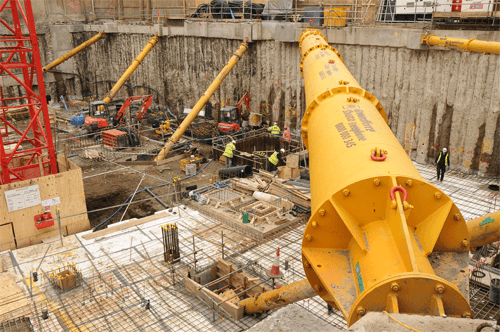Construction of a major new hotel on London’s South Bank has required the excavation of a large two-level basement in poor ground conditions in an extremely built up location. The main contractor is GTM, a joint venture between McGee and Galliford Try, which has taken the unusual step of eliminating the use of subcontractors wherever possible.With extensive groundworks, concreting and engineering capabilities of their own, the joint venture partners are together capable of undertaking most of the specialist packages themselves.
A notable exception to this rule is the use of proprietary hydraulic shoring equipment supplied by support specialist Groundforce Shorco, part of the VP Group of companies.
Such is the complexity of the ground engineering aspect of this project that GTM decided to make an exception to its “no subcontractors” rule and employ a proprietary system which would incorporate a load monitoring capability.
The Project

Splendid Hotel Group is the client for this new eight-storey five-star hotel located just south of the Tate Modern gallery. It will be operated by the Hilton hotel chain and is due for completion next year.
One feature of the project is the two-level basement which will house a health spa, meeting rooms and a ballroom large enough to accommodate 700 people.
Construction of the basement is a sensitive operation as the site is bounded by roads on three sides and a party wall along the fourth. The excavation is deep – down to 7m – and the sides are supported by concrete secant piled walls.
Ground conditions are very poor. The first couple of metres is made ground; below that is a mixture of peat and soft alluvial soil resting on top of the London clay which lies approximately 10m below formation level.
The Challenge
The excavation is both deep, wide and sensitive to ground movement. With a total volume of 28,000 cubic metres, it is one of the largest basements currently under construction in the capital. Supporting the walls of this excavation required propping equipment capable of spanning more than 30 m, although the width is such that approximately half the total length of secant wall has had to be supported with raking props transferring the load to pile-caps or thrust blocks cast into the basement floor.
McGee’s standard approach to this requirement in the past has been to fabricate structural steelwork designed specially for the purpose. However, on this project the amount of steelwork required would have been very high and would have obstructed the contractor’s excavating and concreting operations within the basement area.
Another important consideration was the need to ensure that movement of the ground immediately outside the excavation was kept to an absolute minimum.
GTM decided that it would be desirable if it could monitor the loads acting on the support structure in real-time to act as an early warning system for potential pile movement.
The Solution
 McGee had been in discussions with Groundforce over the potential use of proprietary hydraulic shoring equipment and its joint venture partner Galliford Try had already worked on projects which used Groundforce equipment to support excavations.
McGee had been in discussions with Groundforce over the potential use of proprietary hydraulic shoring equipment and its joint venture partner Galliford Try had already worked on projects which used Groundforce equipment to support excavations.
The major benefits of using Groundforce’s modular hydraulic props on the Hilton Bankside project were, firstly, that this solution would create minimal obstruction. Using Groundforce props enabled GTM to halve the number of supports within the excavation.
Secondly, ‘live’ load monitoring was possible through electronic load pins which relay data via a wireless GPRS system. Groundforce’s solution also had the benefit of quick and easy installation of the equipment. Finally of course Groundforce were able to offer a cost effective solution.
There are lots of things that come with a proprietary system that are just not possible with structural steel.
Paul Gildea, Substructure and Piling Manager - GTM
The Equipment
McGee supplied the capping beam loads and deflection criteria to Groundforce’s major projects engineering team who proceeded to designed the support structure using their proprietary struts.
Four different specifications of hydraulic props were supplied, the largest being three 250 tonne capacity MP250s utilising 1.22mØ super tube extensions to cope with the long spans. These tubes can span in excess of 45m unsupported at this load
The remainder of the support system on this project was provided by nine of Groundforce’s MP125 struts, each with a rated capacity of 125 tonnes. In addition, one HSK80 (80 tonnes) and four MP150s (150 tonnes) struts were also employed.
Technical Support
The decision to use proprietary support equipment from Groundforce was taken at a relatively late stage in the design process which meant that GTM and Groundforce engineers had to work closely in order to adapt the original scheme to the hydraulic equipment.
Particular attention had to be given to designing effective yet simple connection details between the props and the capping beam. This was achieved by casting in steel corbels to accommodate the horizontal props and using Groundforce’s aptly named “birdsmouth” adaptor (see photo on page 2) for the raking props.
A considerable amount of the on-going technical input has been the setup and maintenance of the load monitoring system. Pre calibrated strain gauges in the load pins provide readings which are sent via a GPS link to a central server where the GTM site team can monitor loads in real-time. If necessary the hydraulic pressure in the props can be altered to rectify any unexpected loadings.
With steelwork, you design each prop to a specific load but then you can’t react if the situation changes because you don’t know what’s going on in those props. With this system, we know exactly how the propping system is performing at any time and react accordingly.
Paul Gildea, Substructure and Piling Manager - GTM